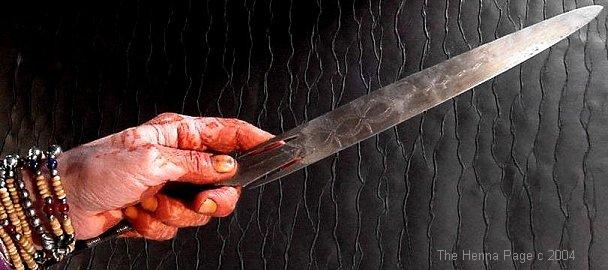
Anath Hennas Her Hands
to Celebrate Baal's Victory over Mot
by Catherine Cartwright-Jones
Kent State University c 2004

|
The epic myth of Baal and
Anath evolved during the early Bronze Age in the area of northeast
Syria, and there are many variants of the myth cycle retrieved and
translated in archaeological excavations. Some of the most
complete and well known of these versions are from the Ras Shamra
texts, from the city of Ugarit. In one of the segments of the
myth, the goddess Anath hennaed her
hands in preparation for Baal's victory
feast, celebrating the defeat of Mot, also known as Yam-Nahar. Anath was a virgin warrior goddess who
protected the
fertility of the
earth. Her brother and consort was Baal, the bull god, who was
identified with rain and thunder. Baal
feuded with Yam-Nahar, also identified as Mot, the god who
personified withering heat, climate disaster, famine, chaos and
destruction. In the feud, Baal was
murdered. Anath searched for Baal, and brought
him back from the underworld.
Baal was thus victorious in his battle with Mot, and Anath gave a great
victory
celebration. Anath prepared herself for
this celebration by hennaing her hands, kohling her eyes, braiding her
hair and putting on her finest adornments. She went into the palace to
the celebration, where there was meat and great vats of wine, and
closed the doors behind her. She then
slaughtered Mot and all of his cohorts, the enemies of Baal. She
first beheaded Mot, then beheaded all of his followers. She hung
their heads over her back, stashed their arms and legs under her belt,
until she waded through the bodies of Mot's dust colored
followers up to her knees. The translation and dating of
the Ugaritic texts confirms that women adorned themselves with
henna to celebrate victory from the Bronze age, 2000 BCE in the
coastal region of Syria. For more information about Anath, and
further interpretation of Virgin Warrior Goddess's actions In later centuries, henna was
still used as a part of victory celebrations, and by "Battle Virgins". References: The Goddess Anath, translated from the Hebrew by Israel Abrams The Magnes Press, The Hebrew University, Jerusalem 1951, De Moor, Johannes C. The Seasonal Pattern in the Ugaritic Myth of Ba’lu According to the Version of Ilimilku Verlag Butzon & Berker Kevelaer, Neukirchen – Vluyn, 1971 De Moor, Johannes C. The Seasonal Pattern in the Ugaritic Myth of Ba’lu According to the Version of Ilimilku Verlag Butzon & Berker Kevelaer, Neukirchen – Vluyn, 1971 Hooke, S. H. Middle Eastern Mythology from the Assyrians to the Hebrews Penguin Books 1963 Return to The Encyclopedia of Henna Index Return to the War Index Can't find what you're looking for? Try: The Henna Page Main Index http://www.hennapage.com/henna/mainindex.html *"Henna,
the
Joyous Body Art"
the Encyclopedia of Henna Catherine Cartwright-Jones c 2000 registered with the US Library of Congress TXu 952-968 |
